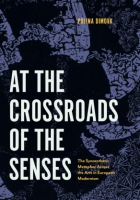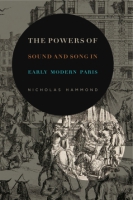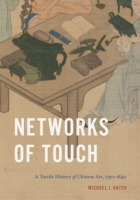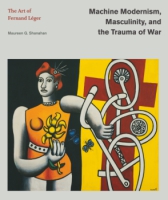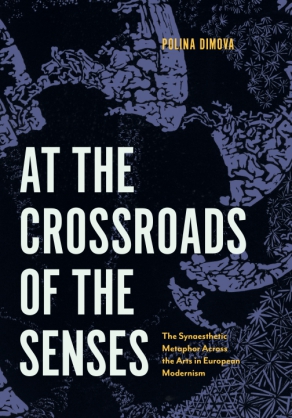
At the Crossroads of the Senses
The Synaesthetic Metaphor Across the Arts in European Modernism
Polina Dimova
At the Crossroads of the Senses
The Synaesthetic Metaphor Across the Arts in European Modernism
Polina Dimova
“Dimova’s volume on synaesthesia, synaesthetic metaphor, and the arts around the turn of the 19th century is clearly a labour of love. . . . It is a treasure trove of period details and surprising connections between the arts, what might be described as an example of ‘intermediality.’”
- Media
- Description
- Reviews
- Bio
- Table of Contents
- Sample Chapters
- Subjects
Structured around twenty theses on synaesthesia, this book explores the integral relationship between modernist art, science, and technology, tracing not only how modernist artists perceptually internalized and absorbed technology and its effects but also how they appropriated it to achieve their own aesthetic, metaphysical, and social goals. Through case studies of prominent multimodal artists—Oscar Wilde, Aubrey Beardsley, Richard Strauss, Aleksandr Scriabin, Wassily Kandinsky, František Kupka, Andrei Bely, and Rainer Maria Rilke—At the Crossroads of the Senses reveals the color-forms and color-sounds that, for these artists, laid the foundations of the world and served as the catalyst for the flourishing exchanges among the arts at the fin de siècle.
Rooted in archival research in Russia, Germany, France, and the Czech Republic, At the Crossroads of the Senses taps overlooked scientific sources to offer a fresh perspective on European modernism. Sensory studies scholars, literary critics, and art and music historians alike will welcome its many contributions, not least among them a refreshing advocacy for a kind of sensuous reading practice.
“Dimova’s volume on synaesthesia, synaesthetic metaphor, and the arts around the turn of the 19th century is clearly a labour of love. . . . It is a treasure trove of period details and surprising connections between the arts, what might be described as an example of ‘intermediality.’”
“Dimova does an excellent job in placing these artists within their milieu, as she situates synaesthetic artistic work at the multimodal intersection of discourses, technologies, multimedia art, and bodily sensations.”
“I have never come across a book or manuscript that explores this topic in such depth, breadth, and detail. Dimova’s overview of the history of perceptions of synesthesia and of controversies surrounding the topic of synesthesia is extraordinarily enlightening, and the synthesis of a wide variety of approaches to this complex topic is impressive and highly readable.”
“The phenomenon of mixed sensations, or intersensoriality, fascinated scientists and artists alike in the fin de siècle, and out of their exchanges there emerged a trope—‘the synaesthetic metaphor’—that held out the promise of the unification of the arts and a radical transformation of consciousness and society. In this sensational account of the wellsprings of the modernist inter-arts, Polina Dimova takes us on a journey that transgresses every conceivable border— including between fantasy and reality—and makes worlds of sense.”
Polina Dimova is Associate Professor of Russian at the University of Denver.
List of Illustrations
List of Music Examples
Acknowledgments
Note on the Text and the Digital Companion List of Abbreviations
Twenty Theses on Synaesthesia
Introduction
Part 1: modernist synaesthesia: art and science
Chapter 1 Synaesthetic Genealogies: Common Sense, Artistic Synthesis, and Universal Correspondences
Chapter 2 Synaesthesia at the Fin de Siècle: Scientific and Artistic Discourses
Part 2: transforming the senses: decadent and symbolist visions
Chapter 3 Deranging the Senses: The Dissemination of Oscar Wilde’s Salomé Across the Arts
Chapter 4 Merging the Senses: The Russian Symbolist Poetics of Light and Aleksandr Scriabin’s Electric Prometheus
Part 3: projecting the senses: from mystical synaesthesia to abstraction
Chapter 5 Sensory Counterpoints: Wassily Kandinsky’s Color- Sounds and the Dissonance of Modernity
Chapter 6 František Kupka’s Synaesthetic Disks: Music, Color, Motion
Chapter 7 “Bright Patches and Dots of Light”: Andrei Bely’s Synaesthetic Abstractions
Part 4: extending the senses: rainer maria rilke’s language as synaesthetic technology
Chapter 8 Translating the Senses: Auguste Rodin’s and Rainer Maria Rilke’s Synaesthetic Fragments
Chapter 9 The Senses, Fragmented and United: Rainer Maria Rilke, Orpheus, and the Phonograph
Coda: Synaesthesia as Constellation
Notes
Bibliography
Index
Also of Interest
Mailing List
Subscribe to our mailing list and be notified about new titles, journals and catalogs.
